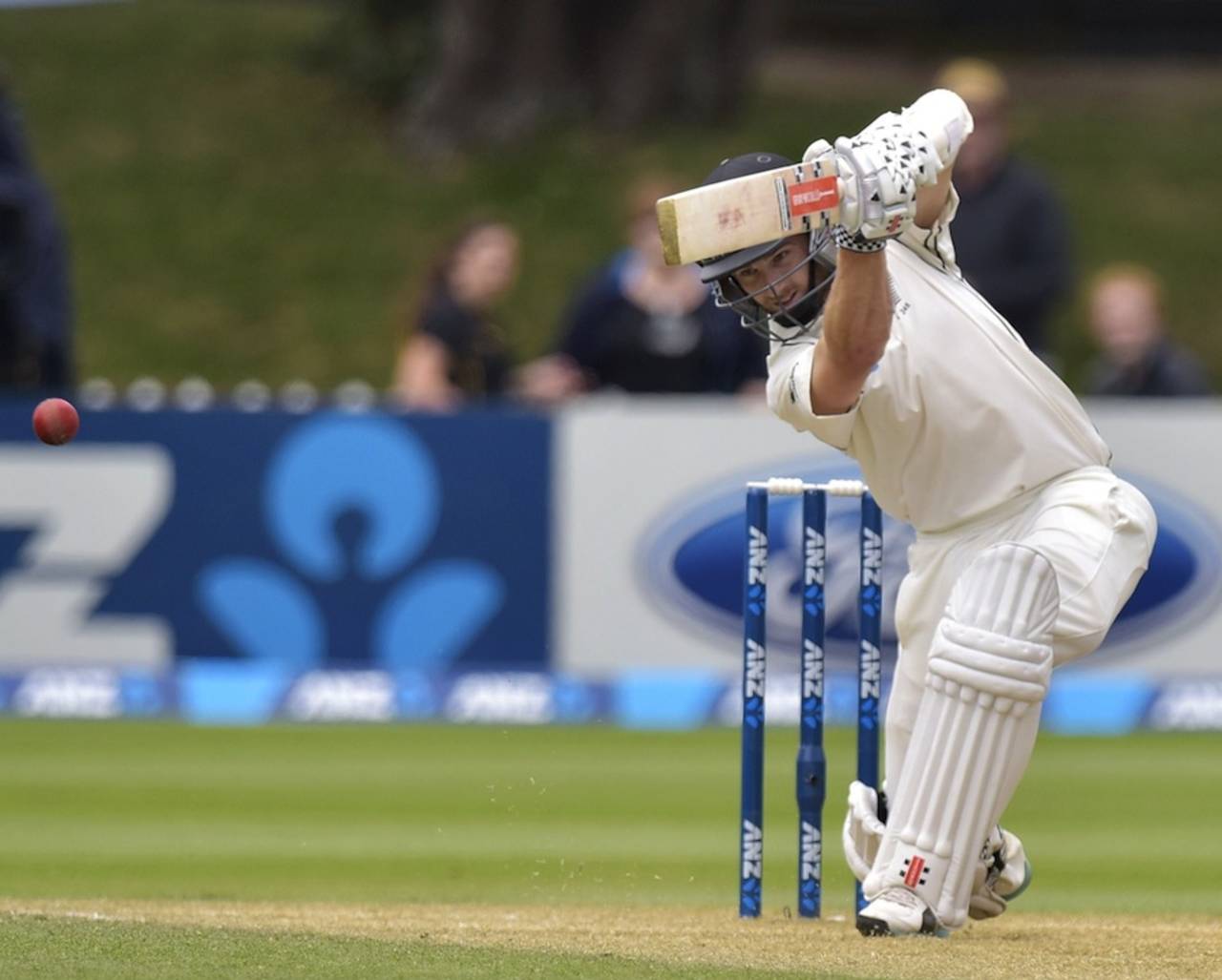New Zealand's friendly neighbourhood game-changers
Kane Williamson and BJ Watlng are good friends who have similar batting styles and scoring areas, and they combined for the sort of tremendous partnership New Zealand are getting used to having
Andrew Fidel Fernando at Basin Reserve
06-Jan-2015

Kane Williamson is not flash, but what he lacks in attractive stroke-play he makes up for with good sense • Getty Images
Eventually you learn to tell them apart, from a distance. Both are slight right-hand batsmen, almost identical in height, and with similar scoring areas.
BJ Watling is the more relaxed in his stance, weight hanging back as the bat draws a tight circle in its back lift. As the bowler lets go, he comes forward, crouched - always looking to pounce, even when his innings strike rate is in the 30s. Williamson is still and straight, back-lift perpendicular to the crease, with knees bent and elbows tense. His form seems the more purposeful, poised over the stumps he always looks likely to protect.
They are good friends, Williamson said after their unbeaten world-record stand of 365. It helps sometimes, to have a kindred spirit at the other end, as the Sri Lanka team know. Sometimes only the supernatural seemed capable of separating Kumar Sangakkara and Mahela Jayawardene, but even they were opposites in so many ways, where Williamson and Watling are alike.
The New Zealand pair are more about the pitter-patter of steady, stable work than a union of science and art, as Sangakkara and Jayawardene were. The closest thing Williamson and Watling have to a look-at-me stroke is the former's back-foot-punch. The only beauty there anyway is its compact efficiency. Between the two, they might have a thimbleful of flamboyance, flavouring their boatload of good sense.
All day long, each man's approach was a mirror image of the other's. The wider balls, whether delivered by blunder or design, were left for the wicketkeeper to collect. Most bouncers were ducked, though occasionally each batsman climbed into a shot; always looking just for the single, wrists rolled over the ball. Even the chance Williamson had given off his hook shot the previous evening had been a mistake. He rolled his wrists then too, but the ball took a slightly higher part of the bat than intended. The major chance he gave on Tuesday, on 104, was from a forward defence.
At no stage did it seem to occur to Williamson or Watling that they could gain more ground via counterattack. In Christchurch, McCullum had hammered Sri Lanka into submission, but this was drip torture. Nothing deflates sides like dropped catches, and although Sri Lanka were never floored by the pair, eventually every run seemed like a taunt. Each boundary brought a fresh wave of regrets.
The chances were only moments of brief static interrupting the music because for such long phases there was no shaking the pair. Even when the run rate slowed, and Sri Lanka sought to choke the batsmen out, the work never felt like a grind. So light were they on their feet, barely a beat was missed. So smoothly did they dip into their more expansive strokes then return to their usual method, that it felt like a few high notes in the melody, rather than a heavy-handed crescendo.

Even when BJ Watling pulled, it was controlled, with rolled wrists minimising risk and maximising New Zealand's chances of controlling the Test•Getty Images
That they stayed fresh in eight hours in the middle together - over 10 hours for Williamson - is further proof of the endurance that has been a New Zealand hallmark this series. In Christchurch, Trent Boult came back at the end of day three to deliver an unplayable ball to dismiss Karunaratne, then continued to bowl at over 140kph, despite having sent down close to 40 overs in the previous 30 hours. Williamson and Watling looked set to bat on for hours when the declaration was called.
Any young batsman might be expected to indulge in a little self-exultation following a maiden double-hundred, but Williamson deflected more praise to his batting partner, and the opposition, than he accepted for himself. Even in that, he and Watling are similar. When Sangakkara had bloodied New Zealand on day two, Watling described it as a "hell of an innings" and a learning experience, instead of dwelling on New Zealand's mistakes. On day four, Rangana Herath didn't even particularly trouble Williamson, save for one chance off his bowling, yet the batsman labeled his control of line-and-length "incredible", though he had made 92 runs off his bowling, and clipped him over midwicket against the turn to get to 200.
Sri Lanka had almost been in sight of victory, with five wickets down and the opposition only 24 runs in front. How they let it slip so far, even when their bowlers were creating chances, will be a question that haunts them if the series is not leveled. Winning this match with Karunaratne already out will take a batting effort better than what the series has yet seen.
Or maybe, given the goodwill plainly clear between these teams, in stark contrast to the dogfight across the Tasman, Sri Lanka will reflect that there is little shame in being bested by a pair of batsmen like this. Likeable, intelligent, highly-skilled, respectful, unyielding and improving, Williamson and Watling lived out everything this New Zealand team hopes to be, and in fact, is already becoming.
Andrew Fidel Fernando is ESPNcricinfo's Sri Lanka correspondent. @andrewffernando